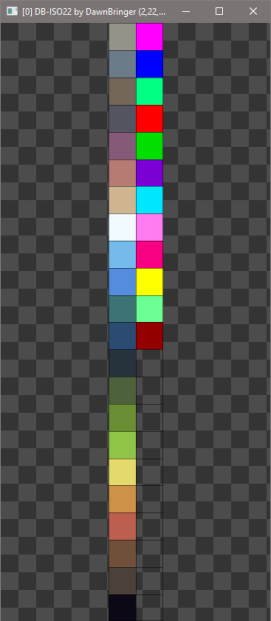I just managed to do it, and even implemented a earlier code into it - G'MIC Challenge - All RGB - #8 by David_Tschumperle
However, I found issues with @David_Tschumperle code

I found that a lot of colors are corners of RGB cube. So, there must be some solution here that can get around that issue.
Purely random non-existent color doesn’t have that issue:

Current code if any one wants to play with it:
#@cli rep_non_existent_color_pal: number_of_new_colors, _appended_into_palette={ 0=do_not_append | 1=append into palette },_method={ 0=random | 1=farthest (slow) },_color_space={ 0=RGB | 1=HSV8 },_cube_size>=7
#@cli : Generates a palette of non-existent colors on each images. Either, appended onto the image, or as a new palette.
#@cli : '_appended_into_palette=1','_method=0','_color_space=0','_cube_size=64'
rep_non_existent_color_pal:
skip ${2=1},${3=0},${4=0},${5=16}
check "isint($1)&&$1>=1"
number_of_new_colors,append_into_pal,cube_size=$1,$2,$5
if isint($3) far_mode={$3&1}
else
r,rand,random,aleatoria=0 far,farthest,distant,lejos=1
far_mode=$$3 if !narg($far_mode) error inval_arg fi
fi
if isint($4) cs={$4&1}
else
list_of_cs_args=rgb,RGB,rvb,RVB,hsv,HSV
$list_of_cs_args={expr('x>>2',narg($list_of_cs_args))}
cs=$$4 if !narg($cs) error inval_arg fi
fi
if $far_mode
if !isint($cube_size)||!inrange($cube_size,7,256,1,1)
error inv_inp_\$\5
fi
if $cube_size==256
initial_code=i(#-1,I)=1
xyz_code=[xM,yM,zM]
m "rep_non_existent_color_pal_insert_new_color: point 0,$""1,0,1,$""2,$""3,$""4"
else
divisor:=($cube_size-1)/255
initial_code=i(#-1,I*$divisor)=1
xyz_code=round([xM,yM,zM])
m "rep_non_existent_color_pal_insert_new_color: point 0,$""1,0,1,{round([$""2,$""3,$""4]*"{255/($cube_size-1)}")}"
fi
fi
convert_colors_fwd=${arg\ $cs+1,error,rgb2hsv8}
convert_colors_bwd=${arg\ $cs+1,error,hsv82rgb}
foreach { # For each images
current_number_of_colors:=whd
if $far_mode
if s!=3 error inv_chans_num fi
if $cs $convert_colors_fwd fi
{vector3($cube_size)},1
eval[-2] $initial_code
if $append_into_pal
1,{$number_of_new_colors+$current_number_of_colors},1,1,y
map[-1] [-3]
rm[-3]
else
1,$number_of_new_colors,1,{s#-2} rm[-3]
current_number_of_colors=0
fi
repeat $number_of_new_colors {
+distance.. 1,2 xyz:=$xyz_code rm.
point.. $xyz,1,1
rep_non_existent_color_pal_insert_new_color. $current_number_of_colors,$xyz
current_number_of_colors+=1
}
rm..
if $cs $convert_colors_bwd fi
else
if !inrange(1,6,1,1)
error inv_chans_num
fi
if $cs $convert_colors_fwd fi
if $append_into_pal
1,{$number_of_new_colors+$current_number_of_colors},1,1,y
map[-1] [-2]
rm[-2]
1,1,1,100%
else
1,1,1,100%x2
fi
eval " # Enter JIT compiler
const number_of_new_colors=$number_of_new_colors;
const number_of_channels=s#0;
const current_number_of_colors=$current_number_of_colors;
const append_into_pal=$append_into_pal;
const maximum_integer_value=256^number_of_channels;
bitshift_factors=expr('x?1<<(2+x)',number_of_channels);
convert_color2int(color_values)=sum(color_values<<bitshift_factors);
convert_int2color(value)=(value>>bitshift_factors)&0xff;
min_pos_val=-1;
max_pos_val=inf;
state_check=mode=0;
old_value=middle_pivot=pivot_value=-1;
repeat(current_number_of_colors,p,
current_color=I[#0,p];
current_value=convert_color2int(current_color);
mode==3?(
state_check=0;
current_value==min_pos_val||current_value==max_pos_val||current_value==pivot_value||current_value==old_value?(
continue();
):(
old_value=current_value;
current_value<min_pos_val?(
min_pos_val=current_value;
da_insert(#-1,0,current_color);
):
current_value>max_pos_val?(
max_pos_val=current_value;
da_push(#-1,current_color);
):
current_value>pivot_value?(
for(q=middle_pivot+1,q<da_size(#-1),++q,
test_value=convert_color2int(I[#-1,q]);
test_value>current_value?(
break();
):
test_value==current_value?(
state_check=1;
break();
);
);
if(state_check
,continue();
,da_insert(#-1,q,current_color);
);
):( # current_value<pivot_value
for(q=middle_pivot-1,q>0,--q,
test_value=convert_color2int(I[#-1,q]);
current_value>test_value?(
break();
):
test_value==current_value?(
state_check=1;
break();
);
);
if(state_check
,continue();
,da_insert(#-1,q+1,current_color);
);
);
middle_pivot=da_size(#-1)>>1;
pivot_value=convert_color2int(I[#-1,middle_pivot]);
);
):
mode==2?(
if(!state_check,
min_pos_val=convert_color2int(I[#-1,0]);
max_pos_val=convert_color2int(I[#-1,1]);
state_check=1;
);
current_value==min_pos_val||current_value==max_pos_val?(
continue();
):(
middle_pivot=1;
mode=3;
state_check=0;
current_value<min_pos_val?(
pivot_value=min_pos_val;
min_pos_val=current_value;
da_insert(#-1,0,current_color);
):
current_value<max_pos_val?(
pivot_value=current_value;
da_insert(#-1,1,current_color);
):
current_value>max_pos_val?(
pivot_value=max_pos_val;
max_pos_val=current_value;
da_push(#-1,current_color);
);
);
):
mode?(
current_value>old_value?(
da_push(#-1,current_color);
old_value=current_value;
mode=2;
):
current_value<old_value?(
da_insert(#-1,0,current_color);
old_value=current_value;
mode=2;
);
):(
da_push(#-1,current_color);
old_value=current_value;
mode=1;
);
);
append_into_pal?(
insertion_pos=current_number_of_colors;
insert_new_color(color)=I[#-2,insertion_pos++]=color;
):(
insert_new_color(color)=da_push(#-2,color);
);
last_rn=inf;
q=0; # Inserted position
repeat(number_of_new_colors,
selec_u=int(u(0,maximum_integer_value-da_size(#-1),1,0));
for(q=(selec_u>=last_rn?q),q<da_size(#-1),++q,
selec_u>=convert_color2int(I[#-1,q])?(
++selec_u;
):(break(););
);
new_color=convert_int2color(selec_u);
da_insert(#-1,q,new_color);
insert_new_color(new_color);
last_rn=selec_u;
);
if(!append_into_pal,da_freeze(#-2););
"
keep[{!$append_into_pal}]
if $cs $convert_colors_bwd round fi
fi
}
um rep_non_existent_color_pal_insert_new_color




